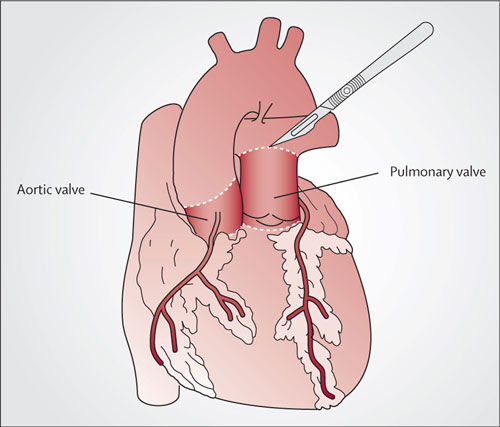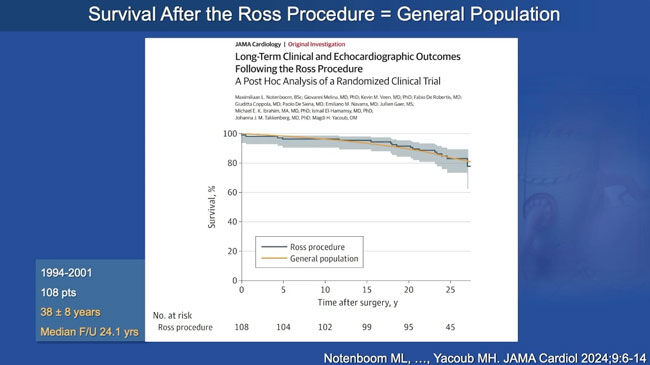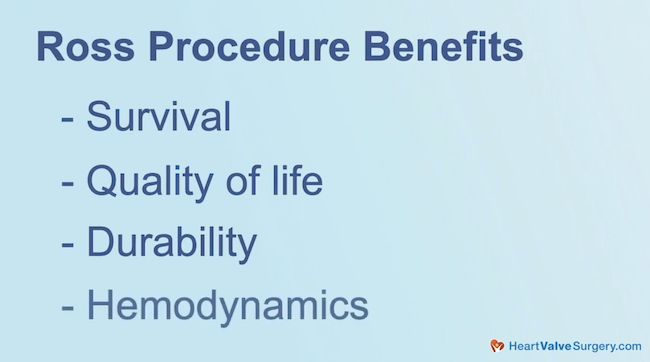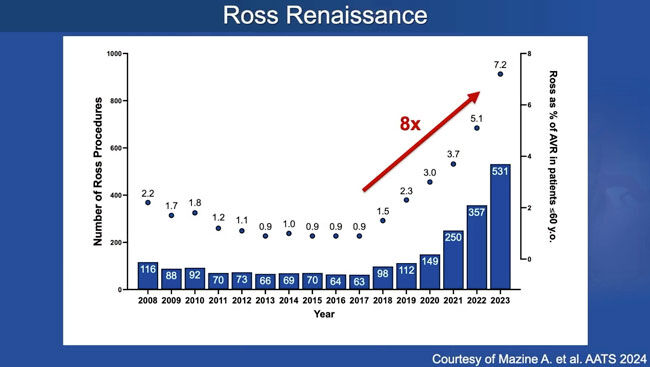Surgeon Q&A: 4 Must-Know Facts About The Ross Procedure
Written By: Adam Pick, Patient Advocate, Author & Website Founder
Medical Expert: Ismail El-Hamamsy, MD, Professor of Cardiovascular Surgery, System Director of Aortic Surgery, Mount Sinai Health System, New York, New York
Published: October 15, 2024
Medical advances in aortic valve disease treatment have given patients more options now than ever before. Unfortunately, it’s not an easy, one-size-fits-all decision about which procedure to choose. There are aortic valve replacement options with a cow, pig and/or mechanical valve. There are minimally-invasive transcatheter therapies. Then, there are aortic valve reconstruction techniques including the Ozaki Procedure and… the Ross Procedure.
 Ross Procedure
Ross Procedure
Given recent durability research, the Ross Procedure is an advanced form of aortic valve reconstruction that has received significant interest from patients in our community. As you may know, I had the Ross Procedure performed in 2005 when I was 33 years old. Since then, I have not had one cardiac issue and I do not take any medication.
To learn why so many patients and doctors are talking about the Ross Procedure, I connected with Dr. Ismail El-Hamamsy, who is a world-renowned Ross Procedure surgeon at Mount Sinai Health in New York City, New York. During his extraordinary career, Dr. El-Hamamsy has performed over 800 Ross Procedures. That said, I was very excited to have this special conversation with Dr. El-Hamamsy and learn his “Top 4 Facts” that patients should know about the Ross procedure.
4 Must-Know Facts About The Ross Procedure
Here are four important facts about the Ross Procedure as shared by Dr. Ismail El-Hamamsy:
Fact 1: Is there any new data about patient outcomes for the Ross Procedure?
- Dr. El-Hamamsy explained that the Ross Procedure involves replacing the aortic valve with a patient’s pulmonary valve, a mirror image of a normal aortic valve. “It’s a living valve that remains alive over the long term,” he said. “Just a couple of months ago, we published a study in JAMA where we looked at a cohort of patients who had undergone the Ross Procedure in the 90s. These were part of a randomized trial we published in 2010 in the Lancet, and we decided to update their follow-up and report the outcomes. Now, into the third decade after the Ross Procedure, this is the longest published follow-up available in the literature. The average follow-up was 25 years, and remarkably, the survival of these patients continues to mirror that of the general population. That is truly unique within the field of valve surgery. There are no other operations so far that have been demonstrated to restore survival that far after the operation.”

Fact 2: Is there a renewed enthusiasm about the Ross Procedure?
- “Absolutely,” Dr. El-Hamamsy said. “Over the last five to seven years, there’s been a true global ‘Ross Procedure Renaissance,’ including North America. It’s all rooted in the evidence that’s been published over the last 10 to 15 years showing the multiple benefits of a Ross Procedure versus a mechanical or biological aortic valve replacement, namely in terms of survival of the patient, quality of life, durability of the operation, and hemodynamics.”

- Dr. El-Hamamsy said that when looking at The Society of Thoracic Surgeons database for North America, they saw more than an eight-fold increase in the volume of Ross Procedures performed over the last five to six years. That amount shows that over seven percent of patients in the United States under 60 are getting a Ross Procedure, as opposed to less than one percent of patients in that age range getting a Ross Procedure six or seven years ago.

Fact 3: What steps are being taken to manage this “Ross Procedure Renaissance”?
- “That’s a great question,” said Dr. El-Hamamsy. “I think the renewed enthusiasm for the Ross also has to be tempered against the potential risks associated with the operation. There is no doubt that the Ross is a more complex operation than a regular aortic valve replacement. For that reason, it is very important to emphasize the notion of Ross reference centers or centers of excellence for reconstructive aortic surgery, which includes the Ross Procedure. There is a clear volume-outcome relationship regarding complex cardiac surgery that has been well established, and recent data presented at the American Association for Thoracic Surgeons meeting last month in Toronto analyzed those North American volumes of the Ross and the outcomes. What they clearly demonstrated was a volume-outcome relationship. Low-volume centers had higher complications after the operation, and high-volume centers had lower rates of complications.
- Dr. El-Hamamsy stressed, “The idea of a Ross reference is not just a surgeon who does a lot of Ross Procedures. The idea is that the patient is in the middle of the story, but a whole team managing the patient ensures perfect outcomes after the operation. Remember, these are all young patients, and we have to be batting 1,000 when we do this. There is no room for any error. So, it takes dedicated anesthetists, nurses, perfusionists, intensivists, and all these people who have seen many of these operations and have a lot of muscle memory, a lot of pattern recognition, and know exactly what we need to be looking for and what we need to be doing to make these operations successful.” Dr. El-Hamamsy added that the operations need to be safe in the short term, and in the long term, they need to be durable.
Fact 4: How has the enthusiasm for the Ross Procedure impacted Dr. El-Hamamsy’s practice?
- “Last year alone, we did over 100 Ross Procedures,” Dr. El-Hamamsy said. “It’s quite a remarkable number, but more proudly, every one of these patients went home well and safe with a successful result. I’m also excited that we’ve recently analyzed the outcomes of 450 patients, and less than five percent of them needed re-intervention after Ross Procedures.
Thanks Dr. El-Hamamsy and Mount Sinai!
On behalf of everyone in the HeartValveSurgery.com community, many thanks to Dr. Ismail El-Hamamsy, for explaining the top four facts we need to know. And, thanks to Mount Sinai Health for its extraordinary care provided to heart valve patients!
- Patient Research Alert: Ross Procedure Survival Advantages & More
- Ross Procedure: 10+ Important Facts For Patients
- Webinar: Ross Procedure Advantages with Dr. Stelzer and Dr. El-Hamamsy
Keep on tickin!
Adam
P.S. For the deaf and hard of hearing members of our community, I have provided a written transcript of this interview with Dr. El-Hamamsy.
References:
- El -Hamamsy Ismail, Toyoda N, Itagaki S, et al. Propensity-Matched Comparison of the Ross Procedure and Prosthetic Aortic Valve Replacement in Adults. J Am Coll Cardiol. 2022;79(8):805-815. doi:10.1016/j.jacc.2021.11.057
- Notenboom ML, Melina G, Veen KM, et al. Long-Term Clinical and Echocardiographic Outcomes Following the Ross Procedure: A Post Hoc Analysis of a Randomized Clinical Trial. JAMA Cardiol. 2024;9(1):6-14. doi:10.1001/jamacardio.2023.4090
- El-Hamamsy I, Eryigit Z, Stevens LM, et al. Long-term outcomes after autograft versus homograft aortic root replacement in adults with aortic valve disease: a randomised controlled trial. The Lancet. 2010;376(9740):524-531. doi:10.1016/S0140-6736(10)60828-8
Video Transcript:
Adam Pick: Hi everybody. It’s Adam with HeartValveSurgery. com. And this is a special surgeon question and answer session all about the four must know facts about the Ross Procedure. I am thrilled to be joined by Dr. Ismail El- Hamamsy, who is a world-renowned Ross Procedure surgeon at Mount Sinai Health in New York City, New York. During his extraordinary career, Dr. El-Hamamsy has performed over 800 Ross Procedures. Dr. El-Hamamsy, it is great to see you again. And thanks for being with us today.
Dr. Ismail El-Hamamsy: Thanks for having me, Adam. Great to see you as always.
Adam Pick: So I am very excited for this conversation, given your commitment to the Ross Procedure and my experience as a Ross Procedure patient. Let’s get started with a big question. Is there any new data about patient outcomes for the Ross procedure?
Dr. Ismail El-Hamamsy: Yeah, it’s interesting, Adam, as you know, the Ross Procedure is basically a replacement of the aortic valve with the patient’s own pulmonary valve, which is a mirror image of a normal aortic valve. And it’s a living valve that remains alive over the longterm. Just a couple of months ago, we published a study in JAMA cardiology where we looked at a cohort of patients who had undergone the Ross Procedure back in the 90s.
These were part of a randomized trial that we had published back in 2010 in the Lancet. And we decided to update their follow up and report the outcomes. Now, into the third decade after the Ross Procedure, so this is the longest published follow up available in the literature. The average follow up was 25 years and remarkably, the survival of these patients continues to mirror that of the general population. That is, that is truly unique within the field of valve surgery. There are no other operations so far that have been demonstrated to restore survival that far after the operation.
Adam Pick: This is fantastic new research And so, you know, my inbox is already lighting up with questions about the ross procedure. Would you say there is a renewed enthusiasm about the Ross Procedure?
Dr. Ismail El-Hamamsy: Absolutely. I would say over the last 5 to 7 years, there’s been a true global “Ross Renaissance” including here in North America. It’s all really rooted in the evidence that’s been published over the last 10 to 15 years showing the multiple benefits of a Ross Procedure versus a mechanical or a biological aortic valve replacement, namely in terms of survival of the patient’s quality of life, durability of the operation, human dynamics. And what we’ve observed in North America, when we look at the STS database is more than eight fold increase in volumes of Ross Procedures being done over the last five to six years, which now amounts to about over 7 percent of patients under the age of 60 in the United States getting a Ross procedure, as opposed to less than 1 percent of the patients in that age range, getting a Ross Procedure about six or seven years ago.
Adam Pick: Dr. El-Hamamsy, I’ve got to ask you, what steps are being taken to manage this Ross Procedure Renaissance?
Dr. Ismail El-Hamamsy: Well, that’s a great question, Adam. I think the that renewed enthusiasm for the Ross Procedure also has to be tempered against the potential risks associated with the operation. There’s no doubt. The Ross Procedure is a more complex. operation than a regular aortic valve replacement. And for that reason, it is very important to, emphasize the notion of Ross Reference Centers or centers of excellence for reconstructive aortic surgery that includes the Ross Procedure.
Why? Because we, there’s a clear volume outcome relationship when it comes to complex cardiac surgery that’s been well established. And there is recent data that was presented at the AATS meeting last month in Toronto that analyzed those North American volumes of Ross Procedures and outcomes. And what they clearly demonstrated was a volume outcome relationship.
Low volume centers had higher complications after the operation, high volume centers had lower rates of complications. So, the idea of a Ross Reference Center is not just a surgeon who does a lot of Ross Procedures. The idea is that the patient is in the middle of the story, but there’s a whole team managing the patient that really ensures perfect outcomes after the operation.
Remember, these are all young patients, Adam, and we really have to be batting a thousand when we do this. There’s no room for any error. So it takes dedicated anesthesia, dedicated nurses, perfusionists, intensivists, all these people having, seeing a lot of these operations, having a lot of muscle memory, a lot of pattern recognition, knowing exactly what we need to be looking for and what we need to be doing for these operations to be successful. Not just in the short term to be safe, but also in the long term to be durable.
Adam Pick: Dr. El-Hamamsy, I can’t thank you enough for working with other medical teams to establish these centers of excellence for the Ross Procedure. I’ve got to ask, how is your practice being impacted by this enthusiasm for the Ross Procedure?
Dr. Ismail El-Hamamsy: It’s been definitely impacted in a very positive way and, and very exciting way. You know, it feels like now we’re tying the science that we’ve been working on for the last 15, 20 years to the actual practice both here locally, as well as, as you said, in many other places where I’ve been lucky enough to be involved to help establish successful Ross programs. How it’s translated here at Mount Sinai is, you know, last year alone, we did over a hundred Ross Procedures which it’s quite a remarkable number but more proudly so, you know, each and every one of these patients went home well and safe with a successful result. And that’s really a tribute to the entire team that I’m very lucky to work with here every single day from anesthesia, nursing, intensivists, et cetera.
That’s really what ensures these excellent outcomes in these patients. And also what I’m excited about is with this developing expertise and these high numbers, we recently. We analyzed the outcomes of these contemporary techniques of doing the Ross Procedure as we’ve been proposing for the last 15 years or so, and at 10 years now, we have very robust data for the first 450 patients. And less than 5 percent of the patients have needed any reintervention after the Ross Procedure. So that’s, I would say, an incremental improvement versus previously published literature. I’m very hopeful that in the longterm at 20 and 30 years, not only will the survival of the patients continue to be normalized, but importantly, that durability of the operation will even be better than what we’ve seen so far in the literature.
I mean, Adam, it’s been an exciting journey so far. I’m really excited to see that renewed enthusiasm. I think we need to temper it. By making sure that patients understand that these are operations that require a certain expertise and they need to seek centers that do a good high volume of aortic root surgery so that it’s both safe and effective in the long term because we don’t want to repeat the mistakes of the 90s where Ross Procedures were done everywhere at low volumes and unfortunately, ultimately, patients end up paying the price.
Adam Pick: Dr. El-Hamamsy. You see a hundred Ross procedures in a year, less than 5 percent reoperation rates in your series, this is downright outstanding. And on behalf of your patients, patients at heart valve surgery. com and patients all over the world.
I can’t thank you enough. for your time, your commitment and your dedication to advancing the Ross Procedure. Thanks so much for being with me today.
Dr. Ismail El-Hamamsy: Adam, right back at you. Thank you so much for having me today. And thank you for all the work you do educating patients and allowing them to understand all of the different options for their bowel surgeries.



